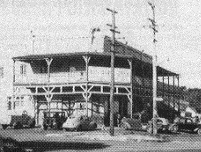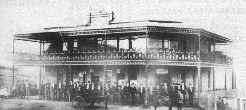 Bill Hanley was granted a licence in 1887 and built the Centennial Hotel near the intersection of Parkes Street and Hume Drive, on the opposite side of the road to where the “new” hotel stands today. The lease of the hotel was granted to Reschs Limited in 1914, the terms being 26 years from 9th June 1914 at a rental of 260 pounds per annum. The lease was between Annie Hanley and Reschs Limited. Shortly after the lease was granted, Reschs erected a new building which was completed in June 1915. The cost was 5,233 pounds. When the new building was competed the licence was transferred from the old site to the new.
Bill Hanley was granted a licence in 1887 and built the Centennial Hotel near the intersection of Parkes Street and Hume Drive, on the opposite side of the road to where the “new” hotel stands today. The lease of the hotel was granted to Reschs Limited in 1914, the terms being 26 years from 9th June 1914 at a rental of 260 pounds per annum. The lease was between Annie Hanley and Reschs Limited. Shortly after the lease was granted, Reschs erected a new building which was completed in June 1915. The cost was 5,233 pounds. When the new building was competed the licence was transferred from the old site to the new.
The hotel relied mainly on the coal miners for trade, and in 1932 the work force in the mine was reduced from about 400 men to 45. This small team maintained the mine and dismantled machinery made redundant by improved technology during the remainder of the depression years. With so few in work the hotel trade declined sharply and eventually the hotel was offered for sale. Tooth and Co. Ltd purchased the hotel on 14th September 1936, for 5,500 pounds.
There is no longer a verandah around the hotel. This was replaced by an awning which means it is not as pretty as it once looked. The hotel still functions primarily as a “watering hole” for local workers and trades people.
 The Paragon Hotel was built of brick, and situated in Walker Street, (now 63 Walker Street) opposite to where Dr. Meates surgery was located. It was built for George Welch in 1889 by Cly Smith & Sons of Enmore, architects Messrs Myers and Hendry, of Edgeware Road, Enmore. Welch was previously the publican at Otford, where he had established “The Grenedier” hotel, a popular meeting place during the construction of the first Illawarra railway line.
The Paragon Hotel was built of brick, and situated in Walker Street, (now 63 Walker Street) opposite to where Dr. Meates surgery was located. It was built for George Welch in 1889 by Cly Smith & Sons of Enmore, architects Messrs Myers and Hendry, of Edgeware Road, Enmore. Welch was previously the publican at Otford, where he had established “The Grenedier” hotel, a popular meeting place during the construction of the first Illawarra railway line.
With the establishment of the Workmen’s Club, one hotel in Helensburgh was sufficient, so the Paragon’s licence was transferred to the Grand Hotel in Burelli Street Wollongong in 1938. Shortly after, the Paragon Hotel was demolished and its building materials and contents sold.
Drinking at the Centennial Pub
One of the more famous drinkers of past years was Sammy Hop. He was the head gardener in the Chinamen’s Gardens. The gardens were situated between McMillan and High Streets, and used the water that passed from the “old” dam through to the Metropolitan Colliery. The gardens occupied several acres, commencing operation during the Boer War and continuing through to the 1930s.
In the early days Sammy would undertake his vegetable run with two baskets on a pole, but later he purchased a horse and cart. Old timers from the Centennial remember Sammy arriving at the end of his rounds and ordering “one lum and one to follow.” When too many “followed”, he would clamber or be assisted onto his cart. Sammy’s horse, unguided by the dozing or singing Sammy, would wander safely back to the gardens.